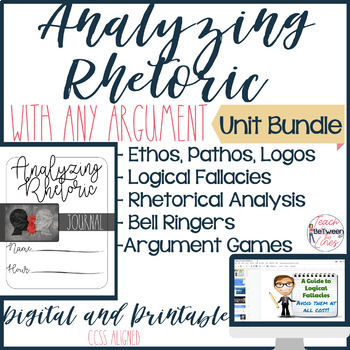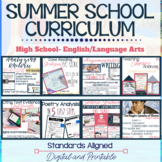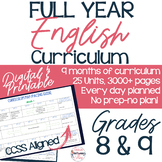Rhetorical Analysis BUNDLE - Analyzing Arguments! Digital for Distance Learning
- Zip
- Google Apps™

What educators are saying
Products in this Bundle (6)
showing 1-5 of 6 products
Bonus
Also included in
- Complete ELA Summer School Bundle will provide you all of the lessons, materials, and activities to teach summer school- ZERO prep involved! From introduction activities and procedure slides (introduced using fun memes) to specific reading and writing strategies that have been the most beneficial toPrice $39.00Original Price $74.14Save $35.14
- This entire year of ELA curriculum will take you from the first day procedures and syllabus to the final end-of-year activities. Every day and every lesson is planned and created for your 8th or 9th grade students which leaves you with a no prep, no planning school year! A detailed curriculum map ouPrice $91.00Original Price $168.28Save $77.28
Description
Analyzing arguments can be so challenging; however, this step-by-step method will make this skill clear and easy while creating an in-depth rhetorical analysis! This digital, engaging, no prep/no plan unit will show your students how to analyze the rhetoric, fallacies, an author's message, and the persuasive language of any author’s argument. Students will then be able to draft a complete rhetorical analysis essay. The graphic organizers provided will support students in every step of this process! This is a digital and printable resource. It can be used for distance or e-learning. This unit will contain a Google File Link Page that will provide you with a Google Doc/Slides for each activity.
Combines the following four complete units!
➀. Ethos, Pathos, Logos Unit Bundle
➁. Logical Fallacies Unit Bundle
➂. Ethos, Pathos, Logos and Logical Fallacies Bell Ringer Activities
➃. Argument Analysis Lesson and Rhetorical Analysis Essay Lesson
☛ Bonus: 5 Argument Games to practice argumentation!
☛ Bonus: Rhetorical Analysis One Pager Activity!
Includes:
➠ Student interactive notebook for the entire unit
PowerPoint and Google Presentation on rhetoric and logical fallacies
➠ PowerPoint Presentation and Google Presentation to introduce this step-by-step method for the rhetorical analysis essay
➠ Analyzing rhetoric graphic organizers
➠ Lesson plans for each of the units
➠ Complete unit plan for all four teacher packs/units.
➠ Lesson plans on teaching close reading strategies with these arguments/speeches.
➠ Google Apps Links to Google Presentations and Google Documents
➠ PowerPoint, and PDF documents included.
➠ Bell Ringer Practice for Ethos, Pathos, Logos and Logical Fallacies.
➠ Rhetorical devices and language student reference sheet.
➠ Links to quality speeches and arguments to close read and analyze.
Links to the following documents are provided for close reading analysis:
Social Justice
☛ Frederick Douglass Speech
☛ Abraham Lincoln’s "Gettysburg Address"
☛ Abraham Lincoln "Second Inaugural Address"
☛ Letter to Albert G. Hodges
☛ Martin Luther King Jr. “The March on Washington Address"
☛ Dr. Martin Luther King Jr. “Letter from a Birmingham Jail"
☛ William Faulkner Nobel Prize Acceptance Speech, 1949
☛ "The Sinews of Peace-Iron Curtain Speech"
☛ “Brandenburg Gate Address” Ronald Reagan
☛ 13 Famous Speeches by Women's Rights Activists
Perfect for personalizing or differentiating learning as it provides a great deal of voice and choice for your learners!
➙ CCSS Aligned!
➙ Great test prep!
Follow my store by clicking on the link at the top of the page for updates, announcements, and fun freebies! You can also find me at my blog, on Facebook, on Instagram, and on Twitter.
Other Analyzing Rhetoric Lessons to Consider:
Analyzing Arguments with Dr. King's Letter from a Birmingham Jail
Ethos, Pathos, Logos- The Three Pillars of Persuasion
Rhetoric- Ethos/Pathos/Logos Bell Ringer Activities!
Rhetorical Analysis-Analyzing an Author's Argument
Save money with these UNIT BUNDLES!
Analyze Arguments: King's Letter from a Birmingham Jail- COMPLETE UNIT BUNDLE!







